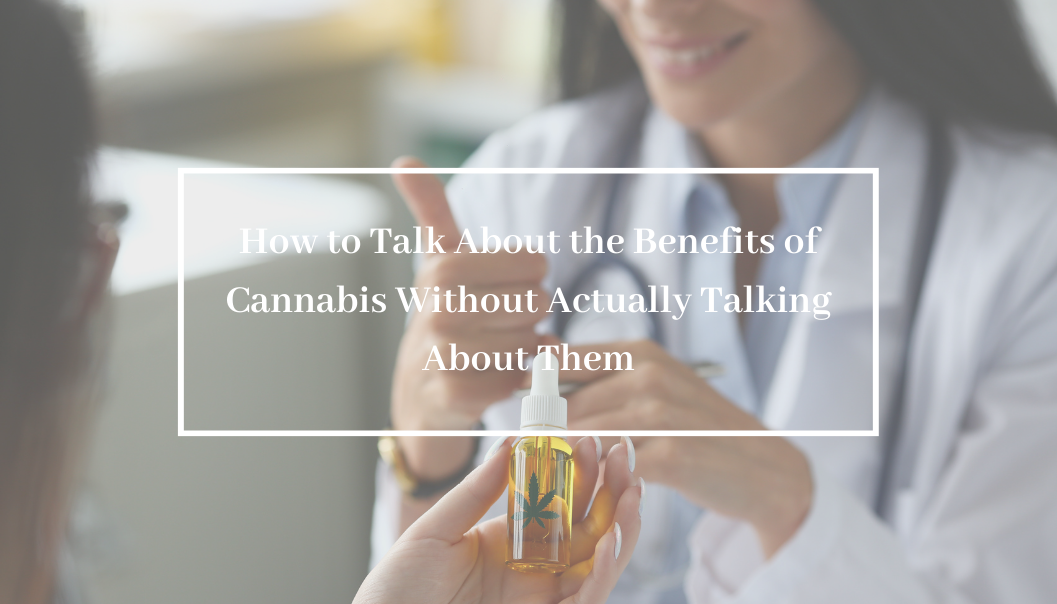
NEWS & PRESS
How to Talk About the Benefits of Cannabis Without Actually Talking About Them
We know by now our magic plant can help relieve a number of physical and mental ailments. It may feel paradoxical that doctors can prescribe it to people struggling with chronic pain, appetite loss, or nausea, but if you walk into a recreational store, the people working there cannot legally disclose many of the benefits.
It makes sense—no one wants an untrained person offering medical advice, or someone in pain avoiding the doctor to self-medicate. But if you’re a cannabis brand, it’s easy to feel that you’re in a stranglehold when talking about the effects of your product.
What are the rules?
You might have read recently that the Federal Trade Commission (FTC) is cracking down on CBD products that make medical claims about easing symptoms of disease or even curing serious ailments and cancers. The FTC is suing several companies, and the individuals behind them, to stop making unsupported health claims immediately, and many must pay monetary judgments to the agency.
You can only make a drug claim if you have received approval from the USA Food and Drug Administration (FDA) on your New Drug Application. This type of approval requires stringent testing criteria that requires millions of dollars in clinical trials. So far, the agency has only approved one cannabis-derived drug product: Epidiolex (cannabidiol), and three synthetic cannabis-related drug products: Marinol (dronabinol), Syndros (dronabinol), and Cesamet (nabilone).
For non-approved products, the rules state that you may not say that your product diagnoses, cures, mitigates, treats, or prevents any disease, or any recognizable symptom of a disease.
You are also prohibited from claiming that your product is a dietary supplement or food because nothing that contains an active ingredient of a drug can be labelled food.
According to Cannabis Industry Journal, “You can use the following words in your cannabis product names, advertising or marketing, as long as you’re not connecting them to a disease state: restore, support, maintain, raise, lower, promote, regulate, stimulate.”
Instead of saying your product cures appetite loss, you may be able to say that it supports a healthy appetite.
Instead of saying that your product cures fatigue, you could say that it’s an energizing and stimulating strain.
Instead of saying that your product eases anxiety, you could say that it promotes calm.
How can we talk about the high with recreational cannabis?
It’s tricky to talk about the high. Beyond cannabis affecting us all slightly differently, per the FDA’s rules, you can’t discuss how your product will alter the structure or function of the body (including the mind), and you also need to avoid any language that promotes overconsumption.
We can take cues from the alcohol industry. You won’t find a liquor brand that will talk about the added social confidence you’ll get by enthusiastically imbibing their products, but they will paint a powerful contextual picture of what your day or evening will look like.
- Is your product a perfect accompaniment to an afternoon of painting or writing music?
- Is it the best product to smoke sitting by a campfire with a bunch of your closest friends?
- Is your product best enjoyed on a Sunday with a specific vinyl collection, cozy socks, and a slow-cooked meal?
Use personal experiences
Guide your existing customers to leave a more impactful review. Find a way to aggregate and display the feelings people are reporting. Leafly does this well by allowing people to choose the icon that most closely relates to how they feel, and place their experience on a scale from calming to energizing. If 9 out of 10 people comment saying that they feel relaxed and happy, you need a way to quickly communicate that to new website users.
Don’t overdo the sensory or tactile description of the flower
In the absence of much to say about the feeling of being high or the medical benefits of their products, plenty of brands rely on describing the sensory elements of the flower: the smell, the color, the size of the crystals. This will inspire and delight a few, but is largely meaningless to the casual consumer, who wouldn’t be able to relate those things to the feeling and experiences of your product.

